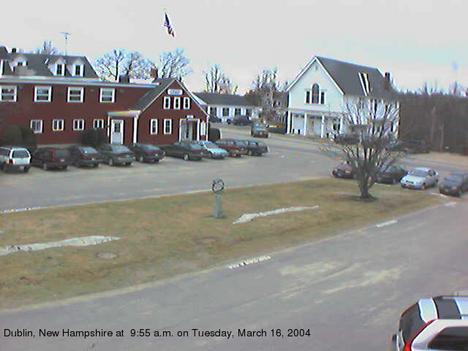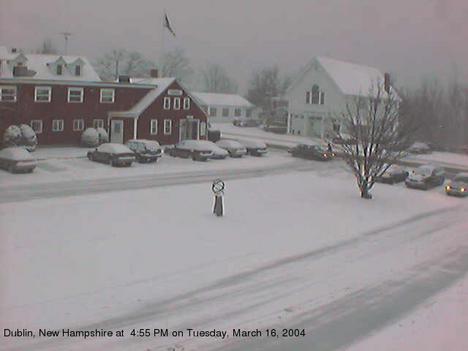If you’re going to fly in the US, check out SeatGuru.com, which rates the seats on most US airlines.
I’m in the market for competitive auto insurance, as Dominion of Canada has just
raised my rates 15% for no reason.
- Car and driver in Prince Edward Island.
- One driver, born 1966.
- Licensed since 1982.
- No violations/convictions/accidents.
- One car, 2000 Jetta 4DR.
- $500,000 Liability.
- Collision - $250 deductible.
- Comprehensive - $100 deductible.
- Driven only for pleasure, approx. 8000km/year
Last year’s rate was $806. This year it’s gone up to $940. Can you do better?
Kent Street Pizza (in the space formerly occupied by Mr. Big Pizza at Kent and Prince) makes good pizza: thin crust, good ingredients, friendly phone staff. A little too much cheese on our test pizza, but we’ll ask them to adjust that next time.
Century City, the new legal drama on CBS set in 2030, is interesting, but I think they’re going to run out of interesting “future legal issue” plotlines before a single season is over. Suggestion to producers: if you’re trying to convince us that it’s 2030, don’t cast Hector Elizondo and Donnelly Rhodes.
TLC aka The Learning Channel, is now almost completely home renovations shows. In prime time you’d be hard pressed to see something that’s not Trading Spaces, While You Were Out, or some variation thereof. Prediction: in the next 24 months TLC will spin off a new channel, called “The Renovation Channel,” that plays nothing else but.
The Formosa Tea House in its new location is a rousing success. The Rice Topping (vegetables and mushrooms over rice) is the star of the new menu. The space is open and bright. New staff are nice. And the Wasabi Peas are back (25 cents a pack at the front counter).
The Taj Mahal, the Indian restaurant on University Ave., is now scheduled to open in April rather than June.
You can fly JetBlue from Denver to Boston for $79US. This is crazy.
You can take the Fung Wah Bus from Boston to New York for $10US. This is crazy too.
Prediction: within 12 months at least one hotel or B&B on Prince Edward Island will offer guests an optional goldfish in tank for the duration of their stay.
This House Has 22 Minutes is no longer funny. Monday Report is funny.
Bruce Rainnie is doing a good job on Compass. Prediction: within 36 months, I will be the only person left on PEI calling the supper hour newscast Compass.
Note to self: On March 15, 2004, a Google search for “Oliver Rukavina” results in three hits. Check back in ten years.
We are on the cusp of that season, known well to those of us who call the northeastern seaboard home, where morning can feel like the fullest bloomiest time of spring only to have a full-fledged blizzard hit by afternoon.
This is what happened in Dublin, New Hampshire this afternoon.
Witness the following shots from The Old Farmer’s Almanac Webcam:


The top shot is from 9:55 a.m. this morning, the bottom one was taken seven hours later at 4:55 p.m.
As reported in this space earlier, I engaged in “extreme packing” for my trip to San Francisco earlier this month.
The untold story behind this (and, to be honest, unrealized truth for me until I arrived there) is that when I was 14 and traveled around the U.S.A. with my father by Greyhound Bus, I overpacked, and was forced to lug way, way too much luggage around the country. For example, I carried not one, but two transistor radios with me. It was the latent memory of this lugging, I think, that got me on the extreme packing plan.
And, of course, there was no small amount of street cred establishing at stake, what given that I was traveling aside my young compatriots/landlords from upstairs.
My usual traveling kit is an American Tourister soft-sided briefcase that holds my laptop, assorted chargers and papers, passport, etc. along with a Jack Wolfskin pack that we purchased to go to Thailand that carries everything else.
For this extreme packing trip, I slimmed down to fit everything inside a smallish Targus knapsack/laptop case. Here’s what I did to shrink down:
- In in addition to the clothes on my back, I carried only two additional changes of clothes, and arranged to do a laundry midway through the trip. I had clean clothes every day, but only needed to carry half as many as I usually do.
- I took lightweight clothes, and I rolled them up tightly to pack them in the least amount of space.
- Rather than carrying a complete toilet kit, filled with every possible toiletry need, I carried a small collection of essential items in the pockets of the knapsack.
- I didn’t carry any bulky books, presents, or other space-sucking items.
- I restricted my gift purchases to small items only.
As a result, I was able to handily fit everything inside the knapsack, which I carried on rather than checking.
While things were still perhaps 2-3 pounds heavier than I would have liked, the effect was rather dramatic: I felt much more mobile, much less tied to my luggage. While I did leave my knapsack at my hotel after checking out on the last day, I could have easily carried it with me.
Here’s a complete list of the contents of my knapsack:
- Two each of shirts, socks, underwear.
- One pair of pyjamas.
- Toothbrush, mini-toothpaste, mini-deodorant, comb, electric shaver.
- Apple iBook, with charger.
- Canon PowerShot S100 digital camera, with charger.
- Nokia 3285 cell phone, with charger.
- 4 feet of telephone cord.
- One copy of Harper’s, one copy of The New Yorker
- Two pens.
- Passport.
Compare this to what Tom Peters carries in his luggage, which includes an eighteen-pound bolt-cutter, and an Australian cricket ball but, oddly, only T-shirts and ball caps for clothing. Hmmmm.
I’m off again in April for another bizarre trip (Charlottetown - Montreal - New York - Boston - New Hampshire - Boston - Phoenix - Denver - Boston - Charlottetown), and I’m going to take another crack at this. Stay tuned.
The CBC is reporting that “Native activist John Joe Sark wants to change Founders’ Hall to reflect the Island’s Miꞌkmaq heritage.” The response from the Capital Commission, through their Executive Director, is:
“Unfortunately, history is such that Aboriginal people were not invited to the table,” she says. “Founders’ Hall acknowledges that, acknowledges the fact that they were not invited, nor were women invited. You know, that’s history and we can’t rewrite history.”
While I agreed with the substance of what Green says, it does beg the question: why have we built a monument that pays homage to a racist, sexist event in our history?
Indeed perhaps we would learn more about ourselves as a society if Founders’ Hall abandoned its rather pointless elevation of the “Fathers” (do rich white men from two centuries ago really need more deification?) and rather concentrated exclusively on that selfsame exclusion of women and aboriginals from the process. I think that the social, cultural, and political forces that allowed for that exclusion are far more worthy of examination, discussion, and public display.
Of course that wouldn’t “sell well” to the bus tours.
And that’s the problem when tourism, rather than building a civil society, is the guiding force behind institutions like this.
I spent two days last week in the pleasant company of my old friend Oliver and his fiance Sophie. Sophie is a vet student; in mere weeks she will be a bona fide veterinarian.
I, on the other hand, am not a veterinarian.
The reason for this is as follows: when it came time to apply for university, I found that the application process to enter the “veterinarian track” involved the composition of an essay along the lines of “why I want to be a veterinarian.”
I couldn’t for the life of me imagine what I would write.
Partly I believe this to be a result of have little interest in animals or veterinary science.
But also, even if I was interested in being a veterinarian, I can’t imagine how, at 18, I would have possessed enough self-confidence to state, emphatically, “why I want to be a veterinarian,” in a manner that would be at all believable to anyone.
All of which leads me to this brief essay, formulated at 3:00 a.m. this morning while in bed, not sleeping, wondering if Oliver was okay. It is my admission essay to enter training as an expositor. I have confidence, though no evidence, that such training is available: I imagine it to be located at an educational mid-point between creative writing and journalism.
I like to write. The process of writing gives me great pleasure and helps keep me sane. Sometimes I write well; mostly I write voluminously, which is sometimes good and sometimes funny.
My problem, though, and my chief reason for seeking training: I feel like the words I write, especially those involved in the description of people, places and things, are too blunt an instrument. My writing lacks nuance.
While I can sometimes insert a “stunning” or a “compelling” or a “vile” or a “crappy” into the mix, much of my descriptive writing falls back on the twin crutches of “wonderful” and “horrible.”
“The sushi was wonderful, but the atmosphere was horrible.” There’s a compelling sentence for you.
I know that language is far more powerful and subtle a tool, and I’d like to become proficient at using it that way.
I know enough to know that. That seems like a good starting point.
Now, are their actually schools of expository writing?
Our family has been cloaked in various sicknesses for the last week, from coast to coast. Most appear to be variations of the flu, or infections of the viral kind.
This all culminated in a visit tonight to the Emergency Room at the Queen Elizabeth Hospital for Oliver. Not because there was an emergency, mind you, but simply because our family doctor was too busy to see Oliver today, and he has been running a fever of 103 for a couple of days. We’re still in the “overly cautious, better safe than sorry” phase of parenting, where the downsides of the eternal waiting room visit don’t yet trump the upsides of a professional diagnosis. So off we went.
I’d be willing to bet that the QEH Emergency Room is the consistently most stressful place on Prince Edward Island. Everyone there is sick or injured. And they’re all being made to wait a lot longer than they think they should, rightly or wrongly (yes, triage is triage, but that doesn’t matter much when you’re in pain).
Like most emergency rooms I’ve seen the inside of, the QEH’s version is decorated in a fashion best decribed as “prison modern.” There are generic, uncomfortable chairs. Old, moldy magazines. A television playing some innocuous channel that nobody is interested in watching. And the room is plastered with various warning signs from floor to ceiling: don’t smoke, don’t use your cell phone, wait your turn, cover your mouth when you sneeze, take a number, stay out of here, and so on.
It is not, let’s just say, a very welcoming place. Add to that the pall of sickness, injury and death that permeates, and the result is a place that serves only to make those forced to wait there more stressed than they started out.
I’m no doctor, but I’ll willing to bet that’s not a good thing, “wellness” wise.
What would it take to turn the QEH Emergency Room from a health gulag into something more welcoming, and, dare I say, pleasant to wait in? It’s never going to be perfect, because people waiting there are still going to be sick and injured. But surely with the investment of a small amount of money and effort, the environment could be significantly improved, couldn’t it?
Surely the benefits — less stress for patients (meaning less stress for staff) and less of a problem with long waits (because they’re not so painful) — would be worth it.
 I am
I am